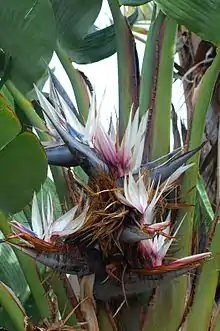Strelitzia nicolai
Strelitzia nicolai, commonly known as the giant white bird of paradise or wild banana, is a species of banana-like plants with erect woody stems reaching a height of 6 m (20 ft), and the clumps formed can spread as far as 3.5 m (11 ft).
| Strelitzia nicolai | |
|---|---|
 | |
| Scientific classification | |
| Kingdom: | Plantae |
| Clade: | Tracheophytes |
| Clade: | Angiosperms |
| Clade: | Monocots |
| Clade: | Commelinids |
| Order: | Zingiberales |
| Family: | Strelitziaceae |
| Genus: | Strelitzia |
| Species: | S. nicolai |
| Binomial name | |
| Strelitzia nicolai | |
| Synonyms[1] | |
| |
The 1.8 m (5 ft 11 in)-long leaves are grey-green and arranged like a fan at the top of the stems, similar to Ravenala madagascariensis. The inflorescence is composed of a dark blue bract, white sepals and a bluish-purple "tongue". The entire flower can be as much as 18 cm (7.1 in) high by 45 cm (18 in) long, and is typically held just above the point where the leaf fan emerges from the stem. Flowers are followed by triangular seed capsules.[2][3]
Strelitzia nicolai is among the few plants which have been verified to contain the pigment bilirubin, which is usually found in animals.[4]
Distribution
Strelitzia nicolai is one of three larger Strelitzia species, the other two being tree-like S. caudata and S. alba. S. nicolai is restricted to evergreen coastal forest and thicket of eastern South Africa from the Great Fish River northwards to Richards Bay. It is also considered native to Mozambique, Botswana and Zimbabwe, and is reportedly naturalized in eastern Mexico (State of Veracruz).[5]
Cultivation
Strelitzia nicolai is commonly grown both indoors and outdoors as well, in the case of warmer climates.
It prefers rich, moist soils with good drainage in full sun to part shade. The plant tolerates light frost. Propagation is via division of clumps, offsets and from seed. Plants require many years of growth before they begin blooming.[6] In favourable conditions they self-seed freely, and their invasive root systems are best kept away from buildings.[7]
Gallery
References
| Wikimedia Commons has media related to Strelitzia nicolai. |
- The Plant List Strelitzia nicolai
- Gartenbau-Gesellschaft., Deutsche; Petersburg., Kaiserliche Russischer Gartenbau-Verein in St.; Petersburg., Russischer Gartenbau-Verein in St.; Staaten., Verein zur Beförderung des Gartenbaues in den Königlich Preussischen (1858). "Gartenflora". Jahrg.7 (1858). Cite journal requires
|journal=(help) - Gibbs Russell, G. E., W. G. M. Welman, E. Retief, K. L. Immelman, G. Germishuizen, B. J. Pienaar, M. Van Wyk & A. Nicholas. 1987. List of species of southern African plants. Memoirs of the Botanical Survey of South Africa 2(1–2): 1–152(pt. 1), 1–270(pt. 2), Strelitzia nicolai
- Pirone, Cary; Quirke, J. Martin E.; Priestap, Horacio A.; Lee, David W. (2009). "Animal Pigment Bilirubin Discovered in Plants". Journal of the American Chemical Society. 131 (8): 2830. doi:10.1021/ja809065g. PMC 2880647. PMID 19206232.
- "World Checklist of Selected Plant Families: Royal Botanic Gardens, Kew". apps.kew.org. Retrieved 2017-08-01.
- "Strelitzia nicolai Plant Profile". Retrieved 2017-08-01.
- Joffe, P. Easy Guide to indigenous Shrubs. Briza Publications. 2003 ISBN 1-875093-40-0
- Botanicas' Annuals & Perennials, Random House, Sydney, 2005



